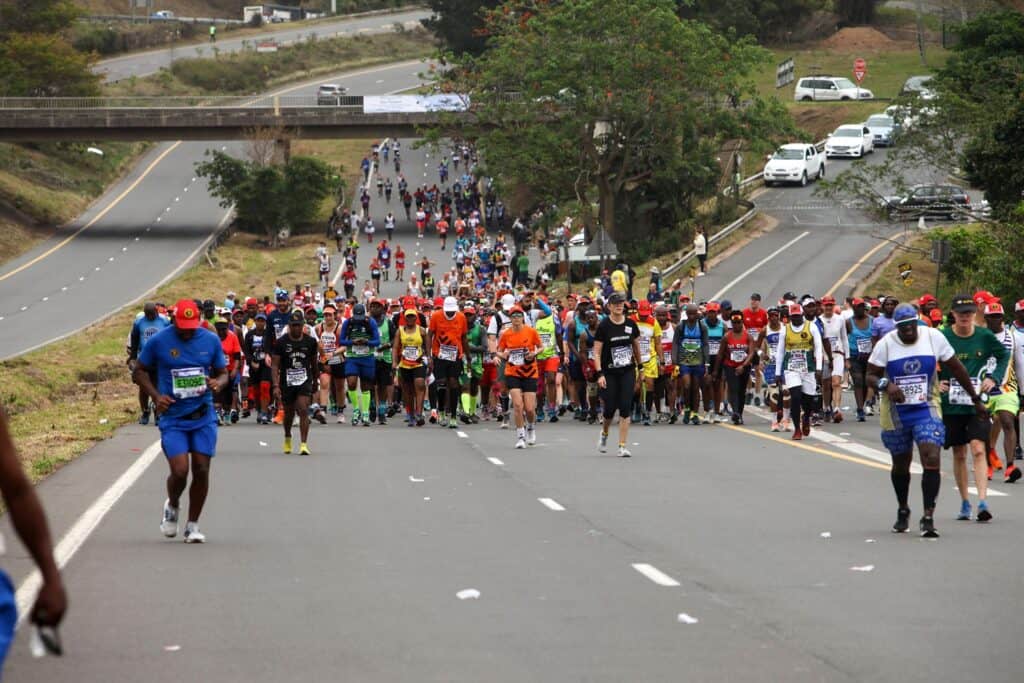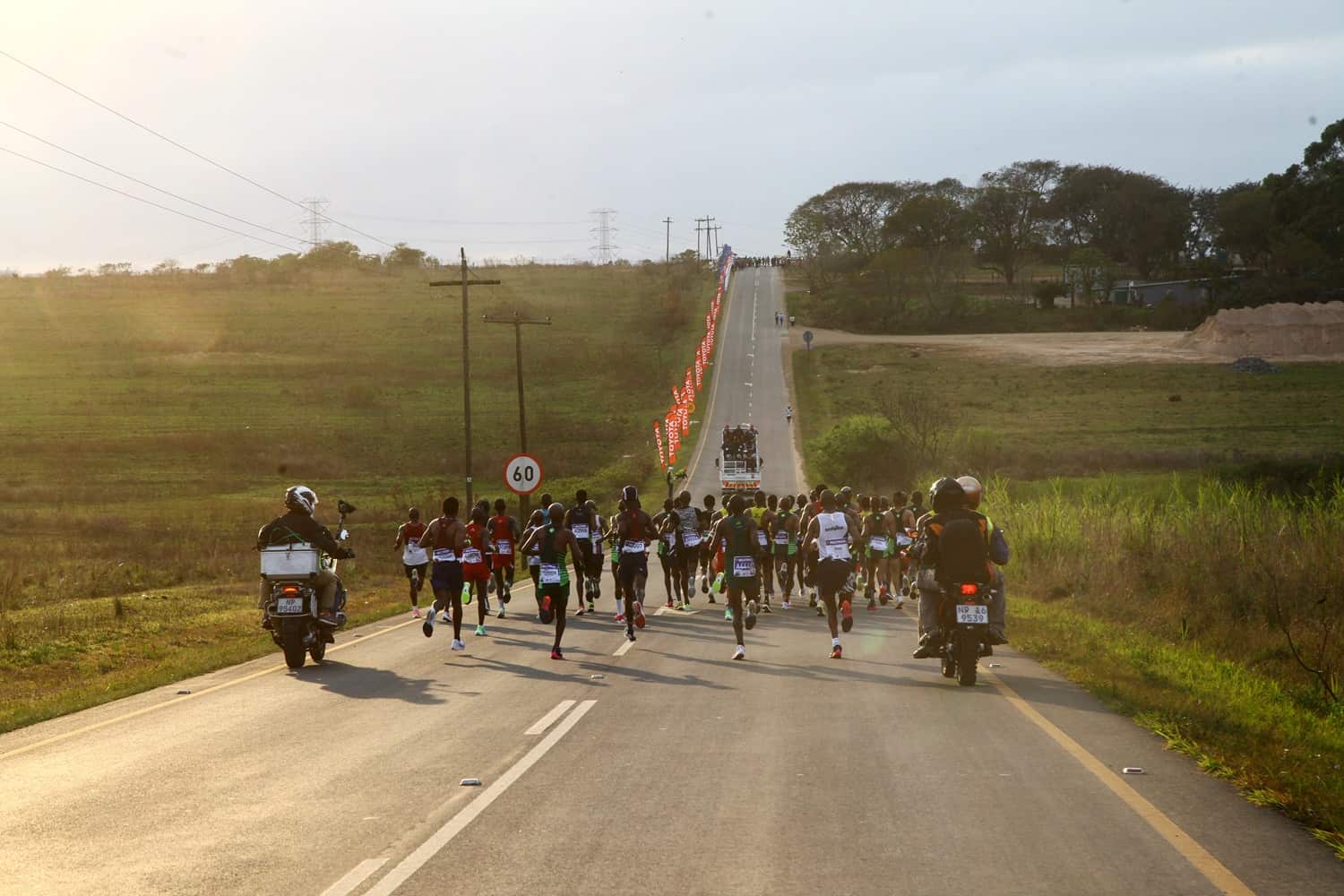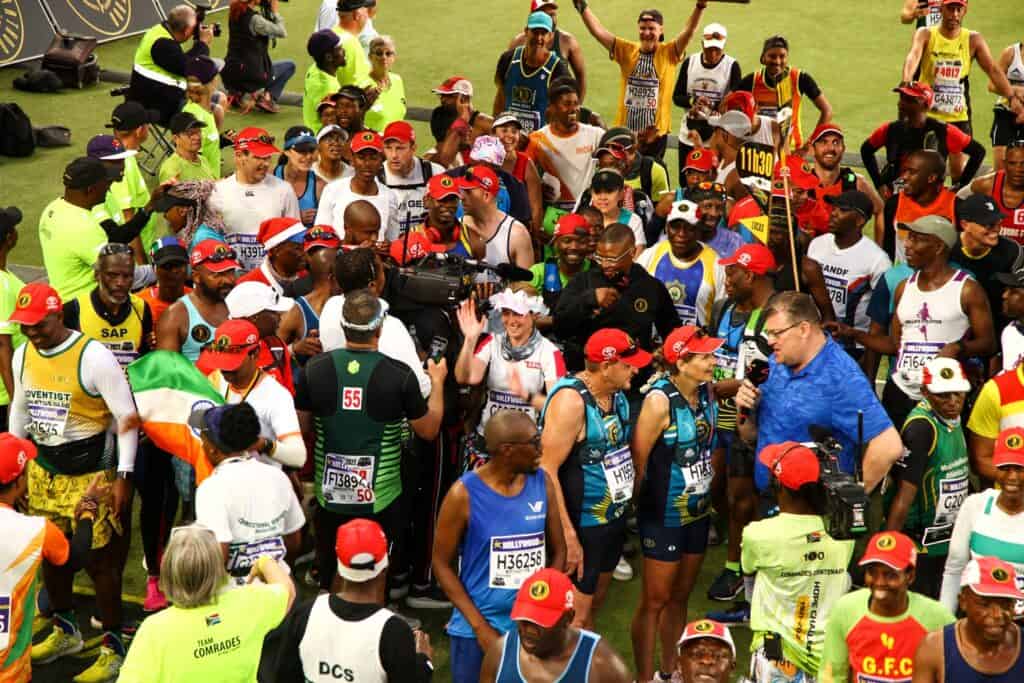It’s all good and well, knowing what the Comrades Marathon Down Run Route Profile is and what hills to expect, and when to expect them.
But the question is, how do you pace them? And how do you do that to run the perfect Comrades?
Let’s have a look at how to pace the perfect Comrades Marathon Down Run...
We’re going to share with you the perfect way to figure out which pacing strategy you should attempt, we’re going to share some examples of pacing charts, and we’re going to show you how to use them.
We’re also going to share with you how you can get your very own pacing chart for your Comrades Marathon goal.
Let’s break the route into 3 parts…
The First Third Of The Comrades Marathon Down Run
The pacing charts are designed to get the most out of each section and ensure that by running each section correctly, you get to the finish line in the best possible way, with the best possible time.
In the first 30 kilometers, you need to be cautious and stick to your pacing chart.
This is difficult, largely because the vast majority of the field has done very little training at Comrades pace.
All their long runs, all the easy runs, while being easy enough for training have been way too fast.
So your pacing governor can’t leap that’s easy enough for 40 to 50 kilometers versus what’s easy enough for 87.7 kilometers.
Your pacing chart is so crucial to how you pace yourself in those first 30 kilometers, you’ve got to take it easy.
The hardest part is for the people that are running for between 11 and 12 hours because you lose so much time crossing the start line, you get into a panic, and then never mind running too fast at your easy pace, you push to try and catch up that last time.
And that is really putting you in a very compromised position for the final third.
So in the first 30 kilometers, it’s very important to stick to the paces on your pacing chart and make sure that you are drifting ahead no matter how good you are feeling, or how easy you think you are running. If you are drifting ahead of that pacing charge, you need to do extra walking.
And that is so important because you have to make sure that you get through that first 30 kilometers doing as little damage as you can.

Pacing The 2nd Third Of The Comrades Marathon Down Run
This section is going to show you what type of day you’re going to have… you’re going to find out if the goal you set for yourself is achievable.
It also is the part of the race where if you are feeling a little fatigue in your legs, you can run easily and if you slowly drift ahead of your pacing chart, you don’t need to panic as this section does have a lot of downhill.
The halfway mark is a really good time for you to check how you’re going, and you don’t want to be more than three or four minutes ahead of your pacing chart.
If you are ahead of your pacing charts, you either need to hope that you are completely wrong about your ability and that you are capable of a much better time than you set out for or you’re really setting yourself up for trouble in the second half of Comrades.
So as you roll through this third, you can really run in as if you’re having conversations with people and you are holding yourself back slightly, then it’s okay to be drifting ahead.
When you get to just before 40 kilometers, just before you hit Inchanga… I strongly urge people to take a run/walk strategy up there so that they can really save doing more damage to their legs.
And then there will be a long drop into the halfway mark.
Now you can run most of that. But it is critical to not do too much damage and pounding to your legs, you want to run, you want to use the down, but you don’t want to push yourself to catch up time through that section.
Once you go through Drummond at 44.3 kilometers, you are then going to get onto what is the hardest time of the day.
The trick to this is to try and get to the top doing as little damage to your legs as possible.
Use a run/walk strategy on that first really hard steep section, I would do something like a one-minute run/one-minute walk, or a two-minute run, one-minute walk.
When you get on to the much gentler middle section on that climb, then you can be less conservative and maybe look at something like a five-minute run, one-minute walk, or three-minute run, one-minute walk.
And then once you’ve gotten past Alveston Mast, the very last steepest section to the back of Bothas Hill, I again suggest doing a run/walk method.
So you don’t want to be forcefully propelling yourself downhill. But you can let gravity sack you along with a little bit …Hillcrest will be fantastic, you’ll just see so many people almost most of you will have people there, that will be something to look forward to.
And from that point on to the top of Fields Hill. It’s really just steady going and not holding yourself back so much anymore. But just make sure that you maintain a consistent effort from the top of Fields Hill with 27 kilometers to go.
The top of fields hill is when you start the final third of the Comrades Marathon.

Pacing The Final Third Of The Comrades Marathon
This is the section where you can be rewarded big time and makeup tons of time. (If you behave on Fields Hill)
When we redesigned the pacing charts with the new distance, we did it as a pure mathematical equation. We got the second half should be 11 minutes faster than the first half.
We know that for the majority of people where there will be some impact of fatigue number one, number two, most people will find it very difficult to go through halfway slow enough to allow them to do that in the second half. And incidentally, I have three clients that have run between nine and 11 minutes faster in the second half showing you that it’s absolutely possible to run quite a lot faster in the second half than the first.
But critically, it tells you that you should, at the absolute very least be able to run them close to even splits. And part of the trick here is to use fuel to run most of Fields Hill, but not to push down Fields Hill.
And even if you don’t push on Fields Hill, what can often happen when you get into Pinetown is that because you’ve been running downhill for so long, because you’ve been running so far up to that point, and because there has to be some fatigue built up at that point in time is that when you hit the flat sections and slight climbs in Pinetown, you can feel like your legs are absolutely dead.
If you carry on running easy and keep yourself moving, that feeling that you had from the constant barrage on Fields Hill which is quite steep, actually pauses quite quickly.
And you get into a groove and a rhythm and you feel quite good again.
Until that rhythm is broken by Cowies Hill.
I suggest running/walking up Cowies Hill again.
This will result in very little damage done to your already tired legs… and now you’re in a great position to run once you get over Cowies Hill.
Now this is the part of the race where if you’ve managed yourself well, you actually can push a little bit. And if you push a little bit over these next 10 kilometers, which are almost all exclusively downhill…then you will get ahead of your time and either beat your current time or lose a little bit of time in those last 5/6 kilometers and end up very close to your Comrades goal time.
You can walk the whole of the 45th Cutting if you like but personally, when I’m at that stage of a race I don’t want to walk for too long.
Once you get to the highway you’ll notice some runners with their heads down driving themselves forward to the best of their abilities to avoid cut-offs, some runners shave paced themselves perfectly and fly across the final 5.5 kilometers over Tollgate Bridge and into Kingsmead Stadium.
Let’s talk about choosing the right pacing chart and pacing strategy for your comrade’s race…
A lot of people make the mistake of where they think they’re going for, let’s call it a sub-11. So they think … “You know what, I’m going to take this sub 10 and a half pacing chart or the sub 10 pacing chart because then I can put the time in the bank that allows me to finish…”
That’s not the way to go.

How to Select Your Comrades Marathon 2024 Downrun Pacing Chart
Of course, we have a new finish line this year… So traditionally, it was one of the simplest equations.
You could take your best marathon time in the past six months and multiplied by two and a half and that will give you a very good idea of what you should and are capable of running at comrades.
Of course, with it being two and a half kilometers shorter this year, we’d be mad to think that that equation works the same, although what I can tell you and this is one of my favorite things about comrades is that with, let’s call them the milestone or cut-offs, where you get a change in the color medal.
It’s amazing how, because of the degree of discomfort you have to put yourself into whether you want to win comrades, or whether you want an 11 hour, you have to dig deep over those last 15 kilometers.
And I think that rather than being 15 to 20 minutes faster than the traditional time tells you, you will be inclined to do the maths and go well actually, I can go a lot easier over the last 15 k’s and I’m still gonna get a bronze, even if I don’t get my 10:45 that I’m capable of.
So…how do I work out what I’m truly capable of on race day?
It is taking your marathon and multiplying it by two and a half. And then take your average pace and multiply that by 2 to 2.5 before then subtracting it from that total.
And then factor in the time that you lost to get over the start line.
So what we’ve done is we’ve built a Comrades marathon finish time predictor that uses that exact formula above.
We’ve put together this calculator that you put in your best marathon time over the last 12 months, you put in the amount of time that it’s going to take you to cross the start line.
And we’ve put a little guide, if you click on the question mark, it tells you depending on what starting batch you’re in, and then it works out what your predicted finish time is, which is amazing.
Click here to calculate your Down Run Finish Time!
From there, you can then select your pacing chart…
Select your Comrades Marathon Pacing Chart here.
If you do want a physical pacing chart that you can slap on your wrist, they will be for sale at the Comrades Expo, the proceeds of those pacing chants go to the Amabeadibeadi charities which are amazing.
Watch this video to learn exactly how to use the pacing chart on race day.

It’s important to remember that we have factored into these pacing charts the time you’re going to lose at the start.
Now that you know how to pace the perfect Comrades… What if you’re on the margins for your time and you’re chasing a sub 9 or a sub 10 or you’re worried about making that 12-hour cut-off?
The good news is we’ve put together an article that you can read right here that’ll show you how to save a ton of time on Comrades race day.



Comments are closed.